-
TrackoBit
Manage commercial vehicles with the new-age Fleet Management Software
TrackoBit -
TrackoField
Streamline your scattered workforce with Field Force Management Software
TrackoField -
Features Resources
-
Blog
Carefully curated articles to update you on industrial trends. -
White Paper
Insightful papers and analysis on essential subject matters. -
Glossary
Explore an alphabetical list of relevant industry terms. -
What’s New
Get TrackoBit & TrackoField monthly updates here. -
Case Study
Explore the cases we solved with our diverse solutions. -
Comparisons
Compare platforms, features, and pricing to find your best fit.
-
About Us
Get to know TrackoBit: our team, ethos, values, and vision. -
Careers
Join the most dynamic cult of coders, creatives and changemakers. -
Tech Support
Learn about our technical support team and services in detail. -
Events
Check out the exhibitions where we left our marks and conquered. -
Contact Us
Connect with us and let us know how we can be of service.
What is Workforce Management? Process & Complete Working
- Author:Nandita Gupta
- Read Time:6 min
- Published:
- Last Update: February 4, 2025
Table of Contents
Toggle
Before you allocate tasks and align your workforce, you must understand the complete mechanism of workforce management processes. Know where it starts and ends!
Table of Contents
Toggle
While many businesses are doubting the potential of having well-laid workforce management processes, some are clueless about it. It looks like both parties aren’t exposed to the benefits well-structured workforce management can provide. Having a well-thought plan to channel the workforce at the office or remote location can help:
- Streamline daily to quarterly processes
- Align manpower on the same page
- Reduce wasteful hours at the job site
Let’s understand in this guide what is workforce management, its working, and the complete process. Along with that, we will also unfold how it adds to the value of an organisation.
What is Workforce Management?
Workforce management is a combination of processes, methods, and ways to effectively monitor and manage diverse teams, which could include an in-house team, field staff, remote or hybrid team.
Workforce management or WFM solutions leverages the use of effective processes, methods, and software that help:
- Assign the right people for the right job
- Allot shifts – upon forecasting regular to urgent work volumes
- Optimise resource utilisation for cost & time saving
- Define workflow and forecast productivity patterns
Benefits of Workforce Management Software
Why should you use it (if you don’t have any)?
Having efficient workforce management software empowers product-based or service-centric businesses by streamlining and automating their redundant tasks. It lets line managers with scattered and diverse workforce access a digital workstation wherein they can:
- Automate the task of assigning jobs or urgent service tickets to the right staff.
- Track their staff’s availability and locational movement through GPS.
- Manage their staff’s shifts effortlessly even during heavy work demands.
- Access task v/s achievement data to compare total tasks assigned and actual tasks achieved.
- Manage the order requests of field staff and give approval for them.
- Helps regulate field staff’s attendance through facial recognition, picture upload with time stamp, and location detail.
- Approve or reject leave requests from staff and accordingly update leave quota.
- Compile accurate salary invoices to disburse salaries on time.
As a result:
The software-aided platform easily reduces the challenges of traditional workforce management solutions.
→ It eliminates ambiguity and reduces the scope of repetitive tasks
—> Brings clarity on who is working on what and who is available
—> Keeps track of every process with up-to-the-minute information
—-> Ensures that assigned tasks are accomplished or are moving according to the decided priority
Let’s explore how workforce management software works in complete depth – without missing a single beat.
How Does Workforce Management Solution Work? – The Entire Process
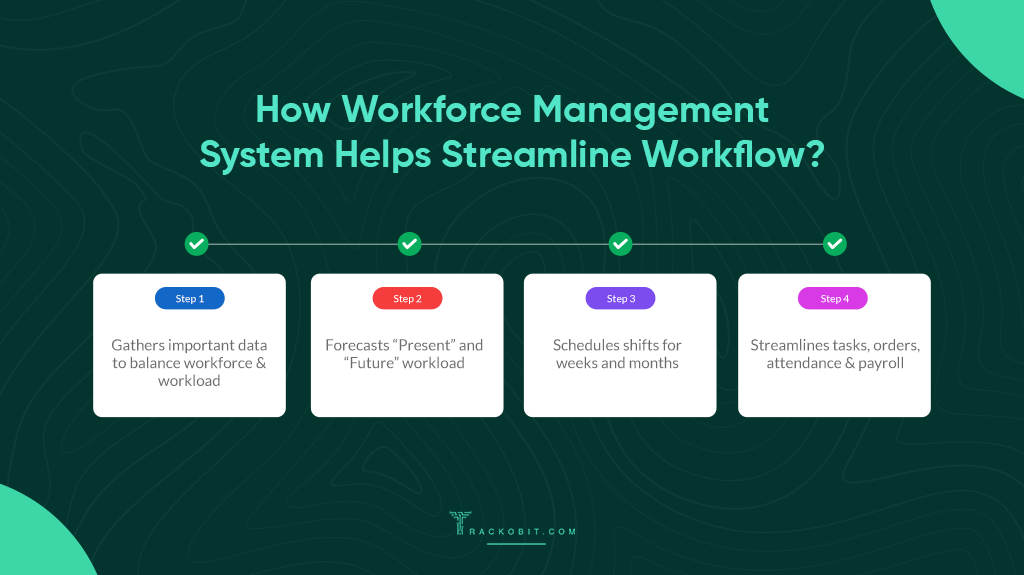
Here are the workforce management processes that are possible to comply with simple-to-use and integrated WFM software solutions.
Step 1 – Gathering Important Data
Managing a workforce starts with gathering and evaluating of relevant data, mainly as:
- Current staff’s strength, team size
- Types of tasks with roles, responsibilities
- Hierarchy structure specifying the reporting pattern
- Total resources required for operations
- Task priority and delivery window
Data is subjective to each enterprise’s needs and use cases.
Step 2 – Forecasting of “Present” and “Future” Workload
After having relevant information on people and tasks, it’s time to decide how you would divide the workload for the short run and long run. You can do it bi-monthly, monthly, or even yearly.
Forecasting workload lets you predict future task volumes and accordingly:
- Schedule and optimize resource allocation
- Enhance processes and efficiency
- Ensure the right teams or people are well equipped to manage required work demands
This helps foster effective planning and ensures long-haul productivity.
Step 3 – Identifying the Total Staff Requirement
Analyze staff’s requirements based on their skills, capacity, availability (especially during peak seasons or heavy work volume), and time spent on each task.
Invest in employees’ time-tracking software to ascertain:
- How much time does each employee take to complete a certain task?
- Which employee is more adept in efficiently completing the given task?
Having this data would help you determine whether you need to hire more people to meet the workload in the future.
Step 4 – Scheduling of Shifts for Employees
If your company works in diverse shift patterns, then you must pre-plan shift schedules for your staff.
Generally, there are two shifts — morning and night. If your company accommodates both then it’s imperative to assign shifts to employees (based on their skills, capacity, and availability).
🔍Find How TrackoField Helps:
—-> Automate Field Service Employees Scheduling and Dispatching
—-> Schedule Last Urgent or Minute Shifts for Field Employees
Step 5 – Track Employees (With their tasks’ progress)
The final step involves tracking employees for their current location and the progress of the assigned tasks. The workforce management system provides a live map where you can locate your executives ‘ current movement. You will know:
- When he/she is halting or idling unnecessarily (away from the assigned task site)
- When he/she is at the client site completing the scheduled tasks (maybe fixing the coffee machine)
- When he got freed from the current call and moved towards the next.
All in all, you will know how your employees are utilising their time and spot it before it overpowers or negatively impacts your healthy returns.
The above factors clearly define the processes and functions of workforce management solutions that are proven to benefit small to large-scale field service businesses.
How Does the Workforce Management System Simplify Field Manager’s Jobs?
The workforce management system like TrackoField comes with oceans of modules and features that allow field managers to elevate the field staff management process:
| 💡Simplifies Shift Scheduling | Managers at quick clicks can assign recurring or last-minute shifts, either weekly or monthly. |
| 💡Simplifies Task Allocation | Managers can easily equip their field staff with service requests or routine tasks based on urgency, priority, or other variables.
They can even assign ad-hoc tasks based on limited availability or shortage of staff. |
| 💡Manage Field Employees Expenses | Managers with expense management modules enjoy the liberty to:
|
| 💡Track Field Staff’s Orders | Managers with an order management module can keep track of the number of orders placed by their field staff. Can approve or reject orders as per the need.
And even request field staff to place ad-hoc orders, while keeping a view of order volume and inventory level. |
| 💡 Attendance & Leave Management | Managers with such comprehensive software enjoy access to geo-coded attendance marking. They can mark attendance based on their employees’ availability on the task site.
Plus, they can plan or hand over task requests accordingly. |
| 💡 Detailed Performance Reports | Managers receive up-to-the-minute data on workforce performance which helps them identify trends, and reasons for gaps and make informed decisions.
Such data allows managers to generate reports on key performance indicators (KPIs) to evaluate the effectiveness of workforce management strategies. |
Here’s What Successful Workforce Management Should Look Like!
Let’s take an example of a service-based business that provides at-home services for cleaning, repair work, etc. Let’s name this business “Rural Company”. When the company automated its processes with field force management software, it achieved the following positive outcomes, defining its success in workforce management.
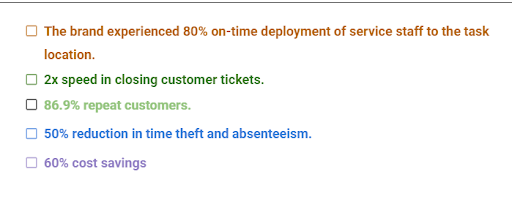
The above results clearly highlight the importance of workforce management. It’s time you get your hands on such software!
Steps to Choosing the Best Workforce Management Solution
While making a selection from the market-offered workforce management software, ensure it offers features to:
| ✓ Simplify assigning of shifts (for daily, weekly, or monthly needs) to multiple staff in one go.
✓ Allocate tasks to field employees based on their skills, proximity to the job site, availability for the day, and 50+ custom aspects. ✓ Mark geofenced attendance and manages leaves according to customer requests and sudden work demands. ✓ Report and acknowledge expenses of field staff for food, stationery, fuel, lodging, etc. ✓ Manage bulk or ad-hoc order requests and acceptance for sheer visibility. ✓ Access to real-time and updated reports & data to know the scope for improvement. Looking for the best workforce management solution that can be customized according to your business’s scaling needs? It’s time to turn towards TrackoField. Doubting its efficiency? Get a Free Trial Today! |
Final Takeaway!
Now that you know how beneficial workforce management processes are, all that is left is to execute and manage them with the help of software. Experience elevated shift and task scheduling, higher visibility through target vs. achievement reports, and under-budget operations. The workforce management software makes it possible to maximise the efficiency of employees, whether operating via the office or remote, far-off locations.
TrackoField is an all-in-one workforce management system that takes care of your task allocation, attendance and leave management, expense, and payroll computation while helping you monitor the employee workforce. It does all of this and more in just a few clicks and commands!
FAQs on Workforce Management
-
How does workforce management work?
Workforce management works by planning, scheduling, and optimizing employees' tasks, shifts, attendance, and admin tasks. All to maximise productivity, and ensure efficient utilisation of resources while keeping in account employees' skills, availability, and preferences.
-
What are the advantages of efficient workforce management?
Efficient workforce management leads to: Efficient and effective utilization of resources Better allocation of employees as per skills, project deadlines, and priority Manage employees' attendance and leave to reduce absenteeism and ensure effective deployment of tasks Saving wasteful hours, reducing redundancy and repetition of tasks
-
Why should you use workforce management software?
You need workforce management software to align work and shift schedules, auto-assign tasks, and manage working hours and payroll data. And all in all, keep an eye on your employees' tasks visibility, efficiency, and productivity level.
-
What are workforce management processes?
The workforce management process includes: Step 1 - Gathering of important data about workflow and workforce Step 2 - Forecasting of “present” and “future” workload. Step 3 - Identification of total staff requirement Step 4 - Scheduling of smart shifts for on-time dispatching Step 5 - Tracking employees’ locational movements with their tasks progress and completion rate.
-
What is the importance of workforce management?
Workforce management is important in every organisation because it helps deploy the right people to the right tasks. It further reduces the wasteful, paper-led operations and syncs every process from shift scheduling to task assignment to successful dispatching of field staff.
Nandita is the Team Lead for Content Marketing at TrackoBit, bringing over a decade of experience in B2B, B2C, and IoT sectors. She has a proven track record of helping Read More
Related Blogs
-
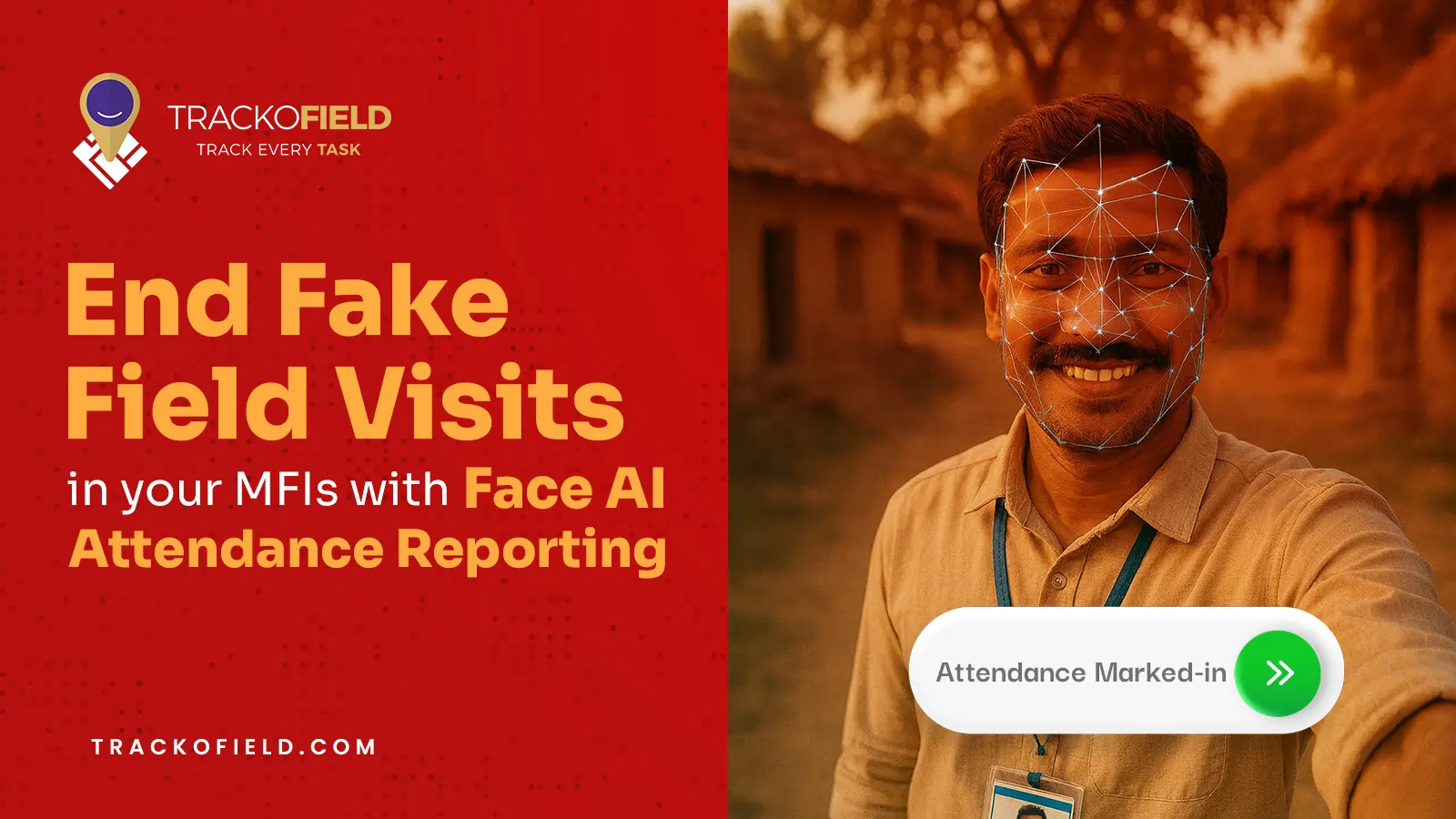
Tired of Fake Field Visits in your MFIs? Face AI Attendance Can Help
Mudit Chhikara November 5, 2025How Face AI Attendance can help end fake field visits in MFIs for good.
-
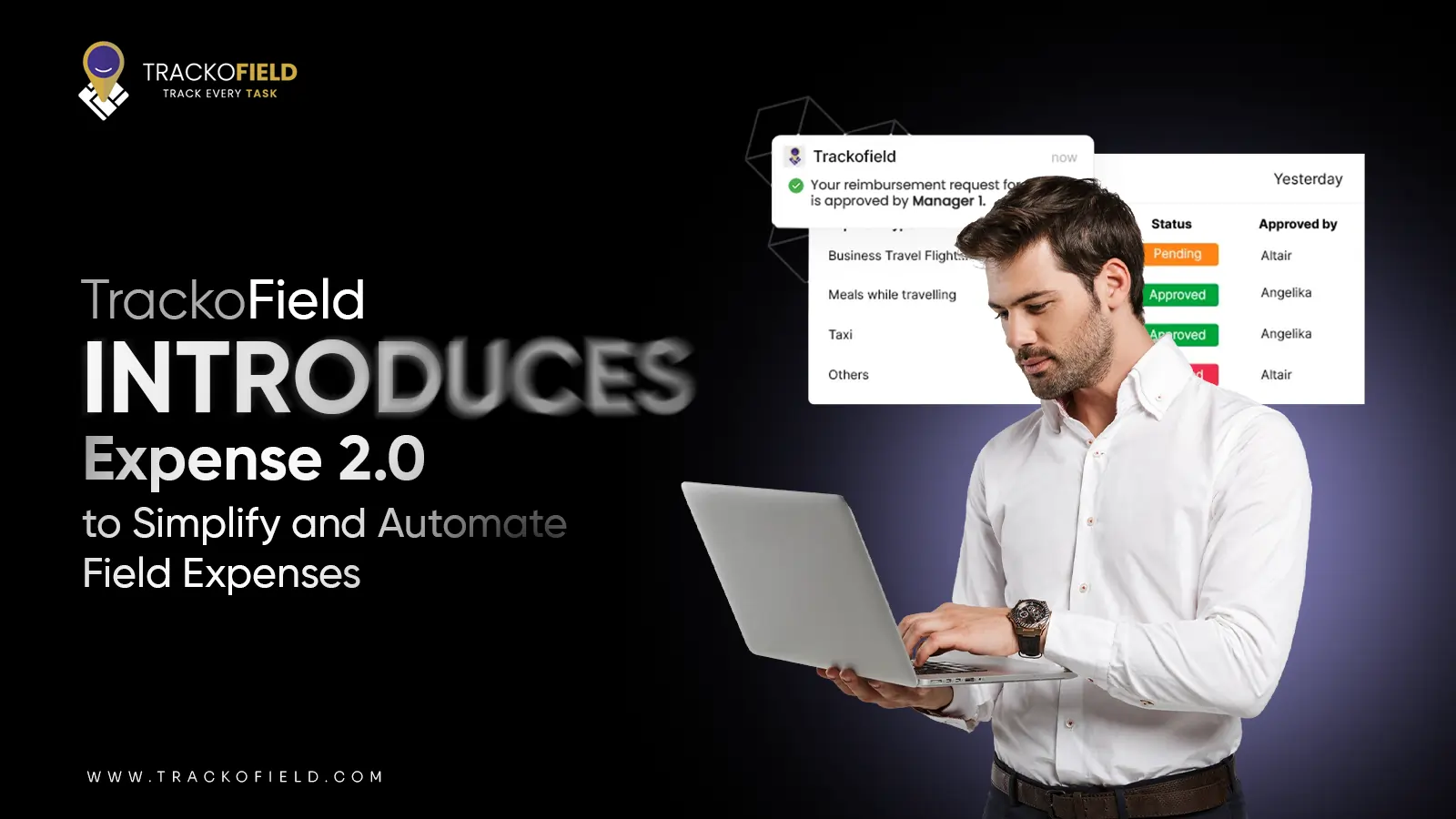
Introducing Expense 2.0: Unified and Smarter Employee Expense Management
Mudit Chhikara October 31, 2025Simplify expense reporting for faster, easier reimbursements with TrackoField’s Expense 2.0 module.
-
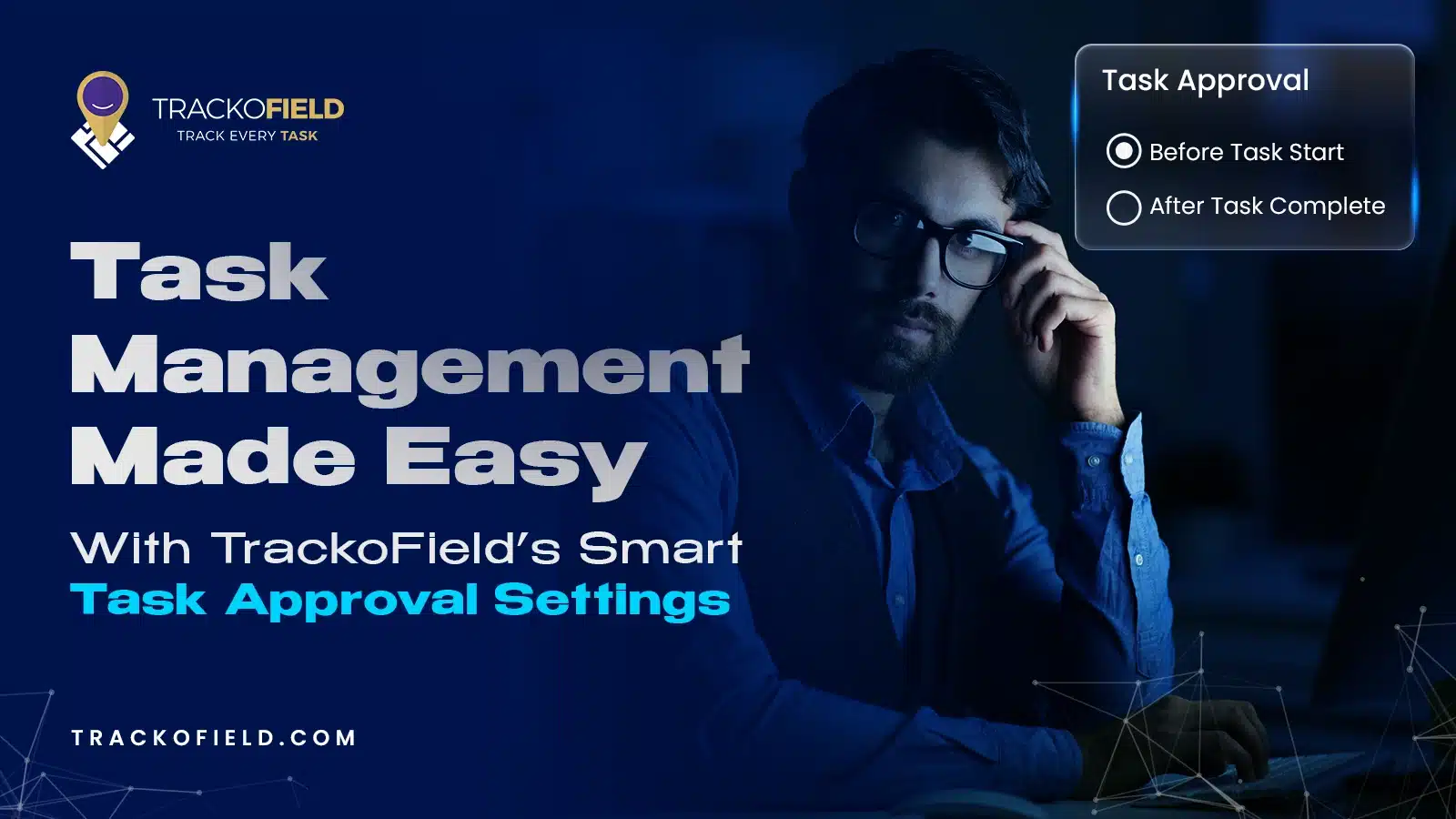
TrackoField’s Powerful New Feature – Smart Task Approval Settings
Mudit Chhikara October 1, 2025Stop fake tasks & ghost visits with TrackoField’s new Task Approval Workflow.
-
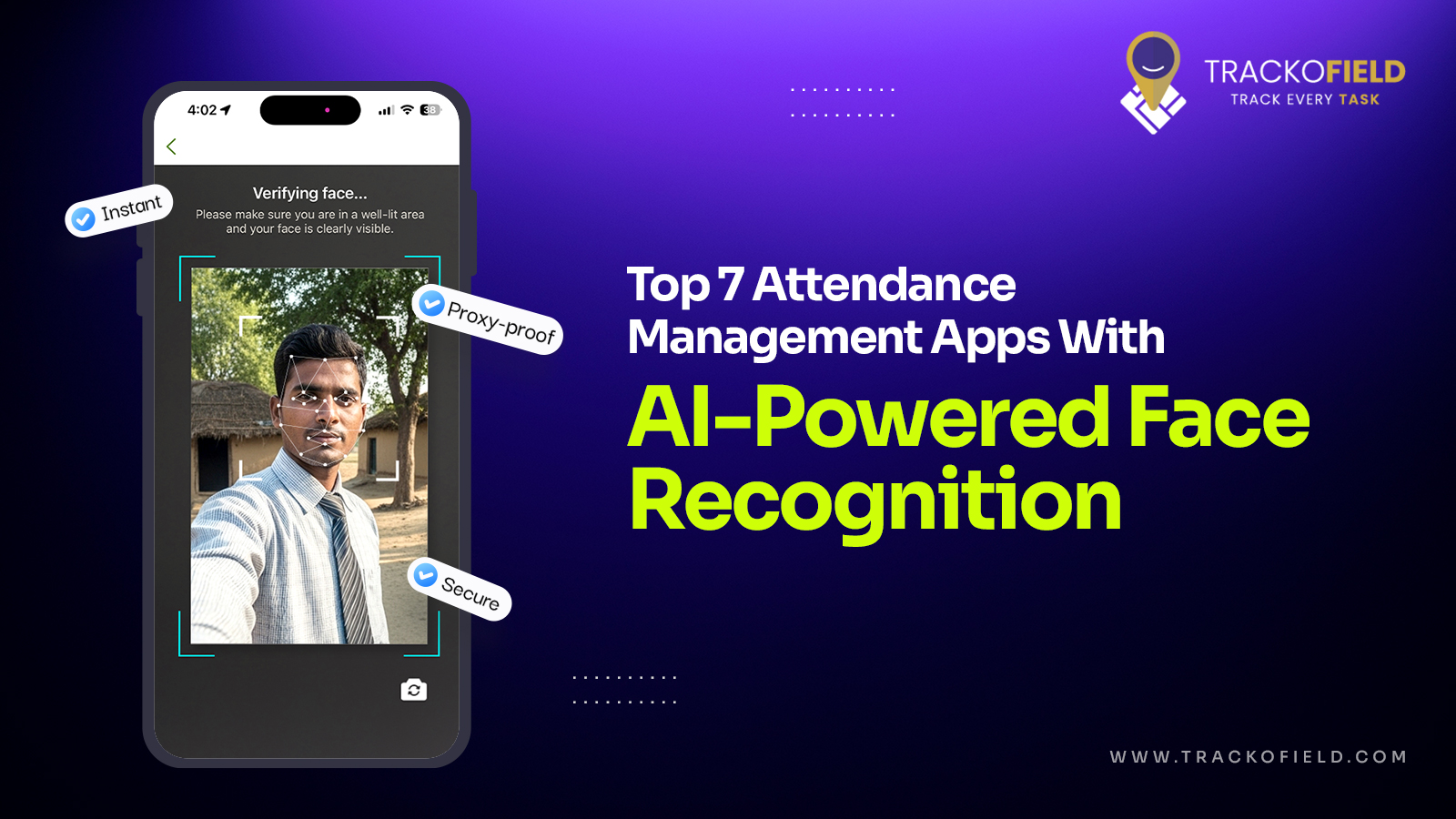
7 Best Face Attendance Apps for Remote & Field Teams (2025)
Mudit Chhikara September 22, 2025Here are top face recognition attendance apps of 2025 to stop proxy attendance and boost field team productivity.

Subscribe for weekly strategies to boost field team productivity.
Your inbox awaits a welcome email. Stay tuned for the latest blog updates & expert insights.
"While you're here, dive into some more reads or grab quick bites from our social platforms!"Stay Updated on tech, telematics and mobility. Don't miss out on the latest in the industry.
We use cookies to enhance and personalize your browsing experience. By continuing to use our website, you agree to our Privacy Policy.


































